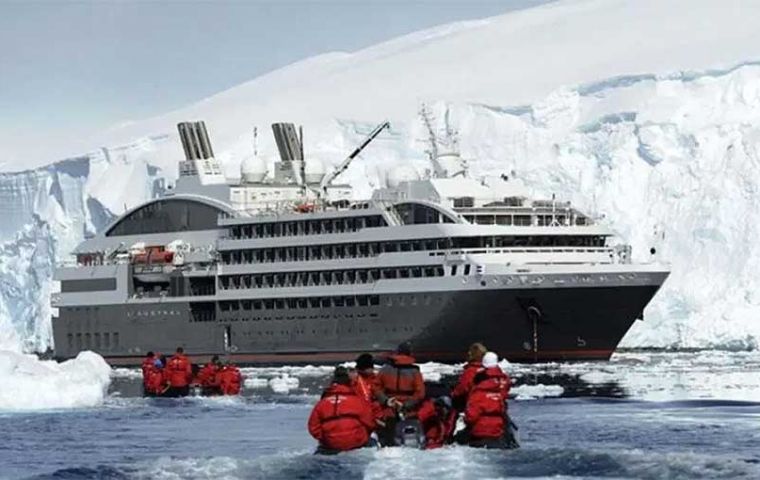MercoPress. South Atlantic News Agency
Plus 400,000 Antarctica visitors forecasted next decade; IATTO’s cautious reply
 Tourist numbers have grown rapidly from some 8,000 in the mid-1990s to almost 125,000 in 2023-24, and a forecast to reach 452,000 by 2033-34.
Tourist numbers have grown rapidly from some 8,000 in the mid-1990s to almost 125,000 in 2023-24, and a forecast to reach 452,000 by 2033-34. A new report published in the Journal for Sustainable Tourism suggests Antarctic tourist numbers could almost quadruple to 452,000 next decade. Icebergs, penguins and almost half a million annual tourists, make up the potential scenario facing Antarctica next decade,
However according to IATTO, the International Association of Antarctica Tour Operators, executive director, Lisa Kelley the report’s forecast of exponential growth over the next decade should be viewed with caution, “since growth is very much tied to the global economy.”
The extreme southern continent might be cold, remote and expensive to reach, but it’s increasingly viewed as a bucket list destination. Over the past few decades, tourist numbers have grown rapidly from some 8,000 in the mid-1990s to almost 125,000 in 2023-24. And according to the report the boom is set to continue, with annual visitor numbers forecast to reach 452,000 by 2033-34.
But the report also cautions that the influx of people and vessels comes with potential risks to the local environment, including: Disturbance of wildlife, vegetation and landscapes; Introduction and spread of invasive species and diseases; Pollution from waste disposal and fuel leaks; Noise and congestion; Non-scientific collecting and Black carbon emissions
“A core concern is that the cumulative impacts of tourism … will interact with climate-change-induced shifts … resulting in widespread habitat degradation and declines in wildlife populations and diversity,” the report states.
During the 2023-24 season 55 tour companies conducted 569 voyages to Antarctica, with about two thirds of passengers on smaller expedition-style vessels that allow landfall.
Most tour companies that go to the region are part of the International Association of Antarctica Tour Operators (IAATO), which requires its members to abide by strict guidelines, including: Restrictions on the size of ships that can land passengers; Coordination of ship movements to prevent congestion at popular landing sites; Limits on the number of tourists on shore at any one time; Biosecurity inspections and protocols; Rules for wildlife watching, including maintaining minimum distances ; Mandatory training for guides and briefings for visitors.
Tourist activities in Antarctica are also subject to environmental impact assessments under the Protocol on Environmental Protection to the Antarctic Treaty. “Travel, when managed well, is a powerful force for good,” said Steve McLaughlin from IAATO member Aurora Expeditions.
“Our idea is to make ambassadors for the planet, “measures recommended to prevent ‘tipping point’.
The new report — compiled by researchers from several Australian universities, QUT, UTAS, CSIRO and two international academies — assessed additional measures that could complement existing guidelines and regulations.
“Our primary goal is to identify practical ways to manage for the potential impacts of this rapidly growing and diversifying Antarctic tourism industry before reaching a tipping point of irreparable change,” the report states. Industry says long-term forecasts are unreliable.
“We’re driven by people who are extremely passionate about Antarctica and about protecting Antarctica,” the organization’s executive director, Lisa Kelley, said. Ms Kelley said the report’s forecast of exponential growth over the next decade should be viewed with caution, particularly because of unforeseen changes in the global economy.
“Growth is very much tied to the [global] economy,” Ms Kelley said. “And right now … in a state of concern over [the] economy worldwide, tourism does tend to slow, particularly to some of the more far-reaching places like Antarctica.




Top Comments
Disclaimer & comment rulesCommenting for this story is now closed.
If you have a Facebook account, become a fan and comment on our Facebook Page!